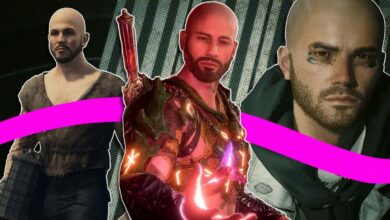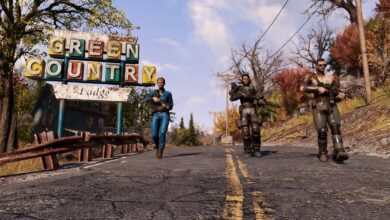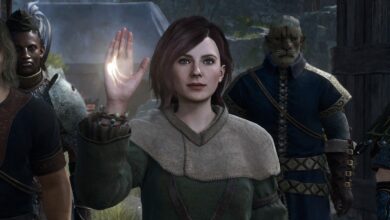Hellblade 2 Previews Say Xbox Might Have A Banger On Its Hands

We’re a little over a month away from the May 21 release of Hellblade 2: Senua’s Saga on Xbox Series X/S, the sequel to Ninja Theory’s 2017 action-adventure game Hellblade: Senua’s Sacrifice. Ahead of its launch, some sites got the chance to check out Ninja Theory’s sequel via a 45-minute preview with the story-driven Nordic mythological brawler. Based on what’s being said from those who previewed Hellblade 2, it sounds like it’s shaping up to be a beautiful nightmare to behold and an excellent showcase of Unreal Engine 5’s abilities.
Read More: Xbox’s Big 2024 Exclusive Looks Intense AF
The sequel follows the eponymous character shortly after the events of the first game, with Senua, a warrior of the Pict tribe, traveling to Iceland to murder the people who murdered her people in the previous game. Though the driving force is revenge, under the surface is a story about Senua’s struggles with acceptance and psychosis as she unravels mysteries connected to her tribe and the old gods that have seemingly forsaken them. It sounds haunting, and the previews underscore that. So let’s check out what some of the previews are saying about Hellblade 2: Senua’s Saga.
In one encounter, I stand with Senua as she grapples with a whirlwind of noise. Internal voices crawl atop one another to offer contentious narration on her predicament, all while an external voice attempts to break through the barrier: an increasingly irate, and intimately-detailed slaver who senses her preoccupation with unseen forces. It’s a disarming, deafening sequence that’s propelled by Ninja Theory’s smart use of binaural audio to lock you into Senua’s reality. “We’re trying to create a sense of depth and space with our sound,” says audio director David García-Diaz. “This is the closest we can get to replicating the sensation of having other voices in your head.”
This was most evident in the final moments of the preview, which saw Senua attempting to free a prisoner from a group of Vikings. Her actions sparked a prison break, engulfing the area in smoke, blood, and screams. I had to guide Senua through an onslaught of foes, some wielding traditional weapons like axes and swords while others used torches to spew fire. Much like the first game, Senua doesn’t face more than one enemy at a time, so huge battles are structured as a series of back-to-back duels. You’d think a decision like this would make combat easier, but nothing could be further from the truth. Hellblade II is hard. It’s not as tricky to grasp as more action-oriented games, but enemies are quick to take advantage of your mistakes—parrying weak strikes and immediately counter-attacking, for example, or using wide-sweeping attacks that are difficult to dodge without precise timing.
The improvements to combat were best displayed in an intense battle that occurred right at the end of the playable sequence. A procession of around a dozen enemies faced off against me with no respite allowed. This battle demonstrated the increased variety of enemy types, with new foes emerging from the shadows to replace their fallen allies. They delivered both quick ranged attacks and heavy close-up blows that put my (admittedly rusty) skills to the test. All of this occurred while all hell seemingly broke loose around me, as innocent victims met swift and vicious demises while fire, flames, and all manner of horror filled each corner of the screen. It was thoroughly exciting and felt like an improvement over the original’s rigid by-comparison combat. Again, it’s not reinventing the wheel here, but turns things up a few notches, adding a desperate edge to each encounter.
In the case of Freyslaug, these remnants of family life serve to elevate the horror of its destruction. The echo of screams aligns with the glistening entrails of human remains, while the frantic whispers of a mother trying to hush her baby accompany the sight of an empty cradle. A mutilated body strung up in ritualistic sacrifice at the head of a wooden bridge brings Senua to a standstill, and as she struggles to process what’s in front of her, a kaleidoscopic portal of whirling limbs, torsos, and faces blocks the path forward. Just like its predecessor, Senua’s Saga employs pareidolia as the crux of its puzzles—a form of pattern recognition that picks out connections in disparate shapes where none exist. As I pick my way through the settlement, runes swim across the screen, prompting me to find a matching shape somewhere in the environment. These puzzles were my least favorite part of Senua’s Sacrifice; not only am I exceedingly bad at them, but I find them fairly reductive as a representation of psychosis. That said, the sensory experience of this puzzle entirely surpasses those that appear in Senua’s Sacrifice, and the longer I spend trying to find what I’m looking for, the further I’m submerged into the near-hypnotic, cacophonic soundscape.
You only need to lay eyes on Hellblade 2 briefly to understand that you’re seeing the next evolution of game technology. It’s not just the engine, though — there are a bunch of factors aligning to make Hellblade 2 a tech showcase. For one, the game design is extremely focused. This isn’t some wild open-world simulation; it’s a linear, narrative-first action game. As an Xbox first-party studio, Ninja Theory has the luxury of building for fewer formats. Also, it’s been given the time to experiment. Touring the studio, Microsoft’s investment in Ninja Theory starts to make a lot of sense. The tech giant hasn’t just acquired a boutique developer, but also an R&D unit that explores the technical and artistic frontiers of a specific game-making process. The result is a game made with an unusual degree of focus. Hellblade 2 won’t necessarily be to everyone’s taste with its slow pace, deliberate inputs, and highly scripted, cinematic presentation. […] It may be a sequel, but it feels like the start of something—like a true next-gen experience should.
The thing that has me most stoked about Hellblade 2 is the evolution of Senua’s psychosis. These moments in the first game were frightening because of the design, in which much of Senua’s bouts with competing voices in her head were illustrated by shaky camera movement, overlapping dialogue, and dark environmental colors. It sounds like the internal struggles aren’t necessarily worse, just more amplified here thanks to Unreal Engine 5 and its processing prowess. Yeah, the game sounds like it’ll be stunning, but on top of gorgeous visuals, the technological advancement that UE5 presents seems to have given Ninja Theory new ways to fine-tune its storytelling. If the previews are anything to go by, Hellblade 2 is going to rule.
Read More: Hellblade II and Alan Wake 2 Are Signs of A Worrying Trend
That’s kind of important, too, when you think about it. Xbox hasn’t had many exclusives this year, so the company really needs a home run, especially when PlayStation has had Final Fantasy VII Rebirth and Rise of the Ronin. With Hellblade 2: Senua’s Sacrifice, it seems like Xbox will be back on the map again.
Source link




